 Met Office reports show that this summer was 1.2°c warmer than the average for the 1981-2010 period and the ninth warmest for the past century. Professor Stoate from the GWCT’s Allerton Project in Leicestersire says, “Not only do these figures reflect the long term trend in climate change but they are also associated with a changing distribution of several insect species.”
Met Office reports show that this summer was 1.2°c warmer than the average for the 1981-2010 period and the ninth warmest for the past century. Professor Stoate from the GWCT’s Allerton Project in Leicestersire says, “Not only do these figures reflect the long term trend in climate change but they are also associated with a changing distribution of several insect species.”
Insects such as some grasshoppers and crickets were not even present in the county until recently. Professor Stoate explains, “On our research and demonstration farm at Loddington the lesser marsh grasshopper started to colonise the farm in 1997, Roesel’s bush cricket started making an appearance in 2002 and other species including long-winged conehead, tree bumblebee and white legged damselfly, have all made an appearance since our project started in 1992. These are just a few examples of species that have seen a north-westward range expansion across the country in recent years.”
“At a time when much wildlife is in decline, the appearance of these species is welcome on the one hand, but on the other, their range expansion across the country carries a more sinister message,” Professor Stoate said.
He explains the vital role that the Allerton Project’s research plays on food production and wildlife conservation, “While it is easy to dismiss the significance of changes in insect communities, we can expect climate change to have more direct effects on our own lives. That does not just mean more frequent storms and floods, but also threats to our food supply.
“Combined with the widespread adoption of heavy machinery, winter rain contributes to water-logged land which causes erosion of soil from fields, and lower yielding crops. In summer, high temperature during flowering reduces the number of grains per ear of wheat, while poor access to water during grain filling, caused by compacted ground and low rainfall, reduces the size of those grains. Food production in north-west Europe is expected to be affected less than in other parts of the world, putting increasing pressure on the UK and neighbouring countries to feed the global population. That has serious implications for wildlife associated with farmland, as well as for us.”
Monitoring of soil moisture at Loddington reveals surface saturation for much of the winter, leading to runoff and erosion, while in the summer, when water is needed to produce grain, soil moisture declines rapidly, even at a depth of 60cm.
While these changes remain out of sight underground, the appearance of new and sometimes noisy insect species is a reminder that we need to prepare for the challenges ahead, in terms of both water quality and food security. Very often, that means better management of soil, an issue which is at the heart of the GWCT’s Allerton Project’s research.
END
Photocaption: The white legged damselfly is just one of the new insect species to have appeared at the GWCT's Allerton Project farm in recent years.
Notes to editors
The Game & Wildlife Conservation Trust – providing research-led conservation for a thriving countryside. The GWCT is an independent wildlife conservation charity which has carried out scientific research into Britain’s game and wildlife since the 1930s. We advise farmers and landowners on improving wildlife habitats. We employ more than 60 post-doctoral scientists and other research staff with expertise in areas such as birds, insects, mammals, farming, fish and statistics. We undertake our own research as well as projects funded by contract and grant-aid from government and private bodies.
For information, contact:
Eleanor Williams
Telephone: 07592 025476
Email: press@gwct.org.uk